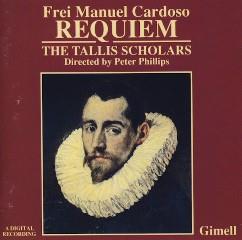Frei Manuel Cardoso - Missa de Requiem (1990)
Frei Manuel Cardoso - Missa de Requiem (1990)

Requiem (47:17) 1 Introitus 8:07 2 Kyrie 4:41 3 Graduale: (I) Requiem Aeternam / (II) In Memoria 6:00 4 Offertorium: Domine Iesu Christie 7:53 5 Sanctus & Benedictus 3:26 6 Agnus Dei I, II & III 3:36 7 Communio: Lux Aeterna 3:29 8 Responsorium: Libera Me 10:05 Motets 9 Non Mortui 3:57 10 Sitivit Anima Mea 3:46 11 Mulier Quae Erat 3:23 12 Mos Autem Gloriari 2:05 - 13 Magnificat (Secundi Toni 5vv) 9:50 Alto Vocals – Adrian Hill, Caroline Trevor, Nigel Short, Robert Harre-Jones Bass Vocals – Donald Greig, Francis Steele Choir – The Tallis Scholars Soprano Vocals – Deborah Roberts, Ruth Holton, Sally Dunkley, Tessa Bonner Tenor Vocals – Charles Daniels, Nicolas Robertson, Richard Wilson (tracks: 9, 10), Simon Davies (tracks: 9, 10)
The Requiem is scored for SSAATB; the closing ‘Libera me’ is for four voices only (SATB), though the style of the earlier movements has been perfectly maintained in it. Cardoso’s idiom is just eccentric enough to make the harmony (as transmitted by the source) at the words ‘Dum veneris’ intentional. The possibility that it is nonetheless a printer’s error remains; but we decided to believe it, even though the result is far from text-book Palestrina. The Requiem was published in the 1625 book of Masses, but it is not known for whose obsequies it was written.
Each of the motets recorded here is a masterpiece, but in a different way from the Requiem. With the exception of Mulier quae erat, they all start with the same monumental procedure which would sound pedantic, the kind of technique one might expect from a conscientious and very late exponent of an old art, if Cardoso had not turned it to such impressive effect: a point is worked at the same time as its inversion, and these are immediately joined by what would later be called a regular countersubject. The working-out of these three strands may last twenty bars, after which the remainder of the text is set in a much more informal way, even allowing some word-painting (for example, the unforgettable flying motif at the end of Sitivit anima mea). In fact, on very close examination, it will be found that even in the Requiem Cardoso regularly employed the principle of a point and its inversion at the outset of a movement. This is necessarily on a restricted scale because of the presence of chant, but it is quite different from Victoria’s more straight-forward choral idiom. At all times, whether formal or informal, Cardoso showed the most beguiling fluency in his part-writing and complete ease with word setting.
Mulier quae erat begins in a different way: the listener is left in real confusion about the tonality of the music, until in bar six it is resolved with the Baroque chromaticisms of what we know as the ‘melodic’ minor scale. The same musical procedure can be heard in the Magnificat (Secundi toni 5vv), beginning at the verse ‘Esurientes’. Cardoso followed this with his most protracted working of augmented chord harmony, which, in conjunction with the uncertain tonality, provides one of the most colourful passages on the whole recording. In this setting Cardoso gave the Magnificat formula, surely a little tired by 1613 when this one was printed, a refreshing overhaul, for instance increasing the number of voice-parts in the final polyphonic passage from the initial five (SSATB) to six by doubling the alto part. Mulier quae erat and Nos autem gloriari (both scored SAATB) were published in Cardoso’s last, miscellaneous collection of 1648. Non mortui and Sitivit anima mea (both scored SSATTB), however, appeared in the same publication as the Requiem (1625) and therefore, since that book only contains Mass-settings, were obviously viewed as an integral part of the music for the funeral rite. ---Peter Phillips, hyperion-records.co.uk
download (mp3 @320 kbs):
yandex mediafire ulozto gett bay files








